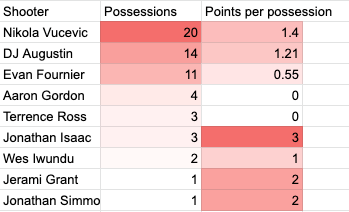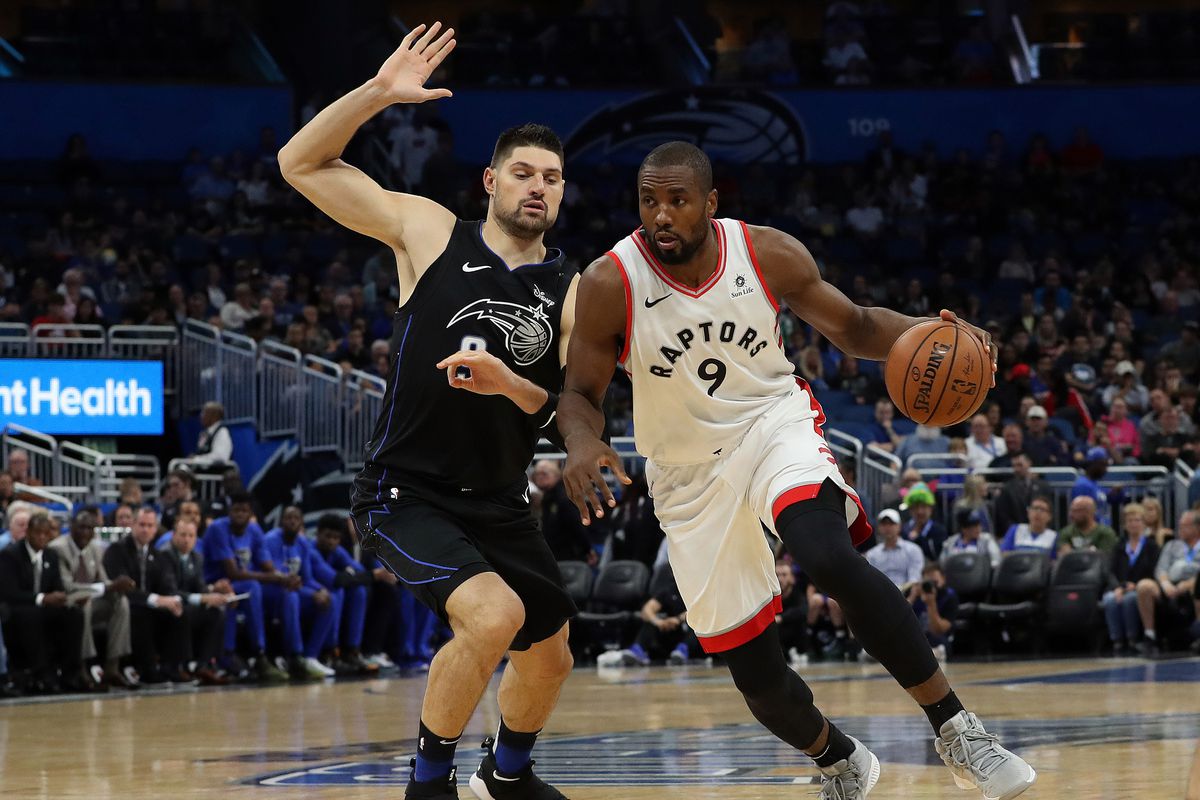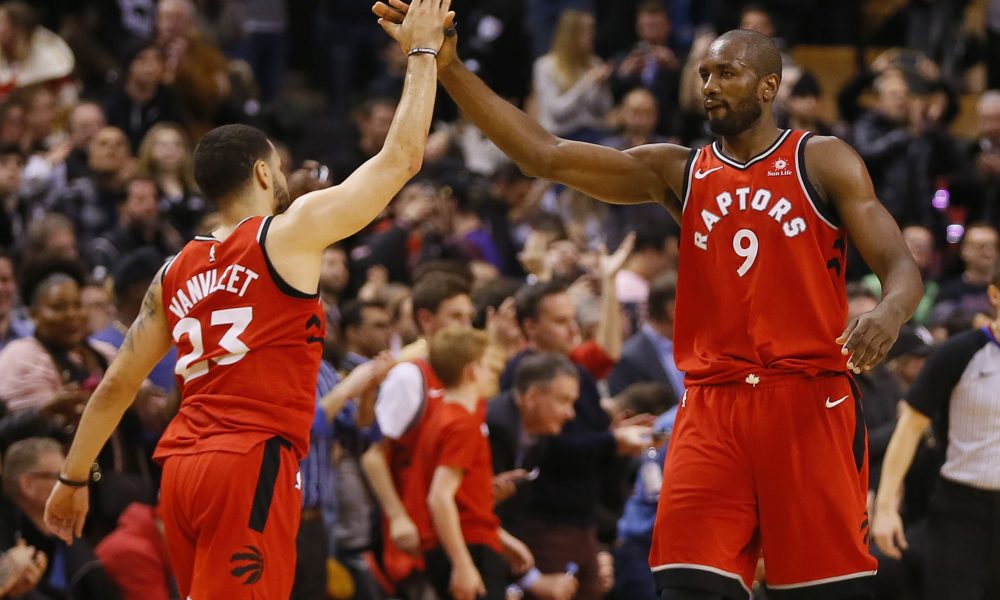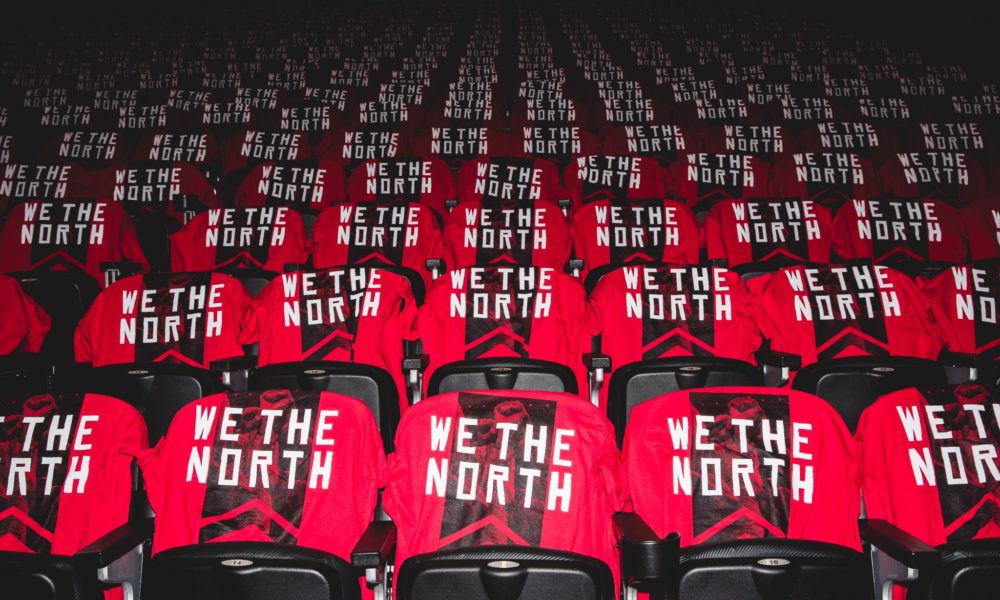I am a lunatic. Because I am a lunatic, I clipped every ball screen the Orlando Magic ran this season against the Toronto Raptors with Nikola Vucevic as the screener. Vucevic is Orlando’s best player, and he earned an all-star berth as the catalyst behind Orlando’s entire offence. His ability to finish as a popper or roller as well as draw defensive attention to open driving or passing lanes was one of the only things that made Orlando’s offence function. He is the offensive star around which all other Orlando bodies orbit.
Orlando used 75 pick-and-rolls with Vucevic screening in four games against Toronto. Some resulted in fouls, and some resulted in deflections out of bounds, but the brunt of them ended in either in a shot or a turnover, finishing the possession. The Magic found great success, accumulating 66 points on 64 plays, or 1.03 points per play. That’s a solid mark for the Magic, especially as they finished the season scoring only 0.94 points per play, according to Cleaning the Glass. Let’s dive into what worked for Orlando, what didn’t, and how both teams’ reactions to the pick-and-roll evolved over the course of four games.
First of all, not all ball-handlers are made equally in Orlando. Note that the handlers were not necessarily the ones shooting in the below chart, simply the initiators of pick-and-rolls that ended in shots or turnovers.

Although low-possession handlers like Aaron Gordon, Jonathan Simmons, and Jerami Grant found some success, the only ball-handler to really hurt Toronto was DJ Augustin. Augustin finished the season scoring 0.96 points per possession as the handler in the pick-and-roll, which is a really solid mark (82nd percentile leaguewide), but far below his performance against Toronto. Some people thrive on revenge.
Augustin is dangerous because he can shoot, finish, and pass. Actually, he’s the only player on the Magic who can do all three things.
It’s worth mentioning that two other Orlando ball-handlers who should be competent with the ball in their hands were hilariously inept against Toronto: Evan Fournier and Terrence Ross. Fournier has a serious aversion to passing, and his instinct while handling in the pick-and-roll is to drive into the midrange, draw both defenders, and sidestep into a contested jumper.
Ross’ poor play in the pick-and-roll was actually due to Toronto’s tactical choices. Whenever Ross found himself dribbling around a Vucevic screen, Toronto always blitzed it. He was the only handler that Toronto blitzed (although that probably will vary more often in the playoffs.) Gasol and Ibaka are both quite comfortable blitzing the pick-and-roll. Gasol has quicker hands and Ibaka quicker feet. Ross isn’t the best ball-handler or passer, so he usually found himself going backwards and almost committing a turnover.
Only once did Ross find Vucevic on the short roll, where he found a wide-open shooter in the corner. If only Gordon could shoot. This shows, though, that Vucevic is very competent as a short roll passer. He combines the shooting and passing of a Marc Gasol with the finishing ability of a Jonas Valanciunas.
If Ross and Fournier cannot improve their decision-making in more reps against Toronto in the playoffs, Orlando could give Gordon more chances handling in Vucevic pick-and-rolls, or they could even make a crazy decision and let Jonathan Simmons get some run off the bench as a de facto point guard. Orlando needs to find a secondary initiator.
Beyond the initiator, Vucevic is the real engine behind Orlando’s pick-and-roll attack. The beauty of Vucevic is not just in his ability to score, but in his ability to open the floor for all those around him. He can, of course, score as the roller or the popper.
As a tactical sidenote, that midrange pop will be available any time Orlando runs a pick-and-roll with an empty strong side; with no Toronto player able to help defend the two-man game, the Raps have to give Augustin an open lane to the basket or Vucevic an open jumper.
The very threat of Vucevic as the roller opens up shots all around the court. In the final regular season contest, Augustin rejected Vucevic screens three times that resulted in an open strongside corner 3. Vucevic creates that much fear. If Toronto tags Vucevic on the roll, his presence will open a jumpshot in the corner for Orlando’s shooters. Jonathan Isaac especially thrived in those situations, hitting three triples against Toronto in three attempts out of Vucevic pick-and-rolls. Here’s how shots after Vucevic pick-and-rolls were distributed between Magic players over the course of the regular season matchup.

(Don’t expect Ross to stay so cold, and he’ll start hitting those weakside jumpers. Iwundu had the largest variance, as he had two shots, both coming as the handler. One was a straight-line drive that he finished, and the other was a straight-line drive that resulted in an airballed layup.) Some hot- and cold-shooting in low possession numbers aside, it’s clear that the ideal scenario for Orlando is Augustin handling, and either the initial handler or screener finishing the possession with a shot. Like Augustin far outperforming his season numbers as the handler, Vucevic’s 1.4 points per possession used as the roller outguns his season number of 1.13.
Part of Toronto’s defensive job is making sure the ball touches someone else’s hands beyond the initial two of Augustin and Vucevic, but that they aren’t open for a triple. Here’s how all of Toronto’s defenders performed, either covering the handler or the screener.

As a note, I only included players still on the team. That’s why the handler and screener possession numbers aren’t the same.
Danny Green and Fred VanVleet were much more effective defending the screen than Leonard or Lowry, and Ibaka likewise had a better time of it than Gasol. Green and VanVleet were especially effective at forcing ball-handlers away from the middle of the floor, otherwise known as iceing the handler. The above chart lines up with the three of VanVleet, Green, and Ibaka having the lowest defensive rating against Orlando among Raptors still on the team. Stop the Augustin-Vucevic pick-and-roll, and you stop Orlando’s offence. The specific numbers from my data dive match the general numbers advanced numbers on nba.com.
Beyond individual tactics like iceing the pick-and-roll – and you can bet that Lowry and Leonard will be more engaged in the playoffs in those scenarios – there are a ton of methods Toronto used to contain Vucevic. They frequently switched the screen and let a center contain Augustin and a guard wrestle with Vucevic. Augustin only punished Toronto once for that, and it came after a stylish split (also his only split of the pick-and-roll defenders against Toronto.)
More often, Vucevic was the one to punish the switch. When Toronto switched anyone other than a center onto Vucevic, he immediately lumbered down to the block and looked to seal. Only the centers on Toronto have any chance against Vucevic. Guards are hardly a bother.
Even if Vucevic doesn’t get the shot up, he can dominate the offensive glass with a guard trying to wrestle him alone.
Toronto adapted to Vucevic’s post-ups against switches by scram-switching , which is basically a second switch. A Toronto big took Vucevic from the guard before the ball could be entered into the post. This had some success when Orlando reversed the ball and wasn’t decisive in hitting the post immediately.
If a secondary big, like Siakam, picks up Vucevic, Toronto still could run into trouble. Siakam can’t deny Vuceivc the ball in the post forever. When he catches and backs down, Toronto has to send help, which opens up triples elsewhere on the court if the defence makes any mistakes. Help too far, and it’s over.
If Toronto doesn’t help after the scram switch, Siakam is alone on an island with a monster.
The best option Toronto found was the middle road. They switched and let Vucevic attack the post, then they attacked him decisively from creative angles. When he kicked the ball back to the perimeter, Toronto nailed their rotations and closeouts, and it took all advantages away from the offence. It helps that Orlando lacks a stable of high-level, quick-trigger shooters.
Other than the switch, which had the most nuance of all defensive techniques in the regular season series, Toronto had other methods of containing the pick-and-roll. The general approach was to simply go over the screen, taking away Augustin’s pull-up, and have the big defend both players for an instant. If both initial defenders attacked the ball, by design or mistake, it’s on the weakside to tag Vucevic’s role especially hard and keep him from an easy lob. If the ball gets moving, then Toronto defenders have to nail their rotations to stay a step ahead of the ball. This is called an x-out because Lowry (Fournier’s defender) and Anunoby (tagger) cross paths during their closeouts, forming an ‘X’ shape.
Or, if Siakam is the tagger, he is such an athletic monster that he can close space with the corner and take away the shot by himself. This play is probably the most impressive defensive sequence of this entire piece.
When Augustin has the ball and Ross isn’t on the floor, Orlando doesn’t have any shooters who terrify defences. Toronto can double the ball and have their entire weakside defence cheat into the paint to take away Vucevic’s attack. Orlando is left with nothing.
It’s clear that there are a ton of methods to defending the pick-and-roll, and I’m sure that there are several we haven’t yet seen. For example, Toronto could throw Leonard or Siakam onto Augustin. If Orlando wants to use the Augustin-Vucevic pick-and-roll, Toronto would switch without requiring a scram-switch after; just help and communicate your rotations. Orlando would be forced into contested, off-the-dribble looks.
If Toronto doesn’t find a way to contain the pick-and-roll, Orlando’s offence will hum along, and their defence will win them games. If Toronto chokes Orlando’s pick-and-rolls into poor looks, then the game is already over. We know who has found success in Vucevic pick-and-rolls for Orlando, and we know which Raptors have found success defending them. That can inform what we expect from the playoffs. But tactics will change, and numbers reset to zero. The past is not necessarily what will happen in the future. But even if we don’t know how they will unfold, keep an eye Vucevic ball screens. One way or another, they will help decide the outcome of the series.
…..
Editor’s note: All data is taken by me, by hand. If you want to check it all out here, there’s lots more fun detail, such as when Orlando rejected or accepted the screen, Toronto’s level of contest, and what coverages Toronto used to defend the screens. There’s plenty of categorizations that don’t line up with NBA parlance, so don’t take my screen defence notation as gospel.




